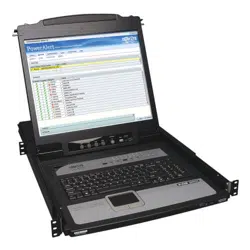Loading ...
Loading ...
Loading ...

59
7.3 Log Server
The Windows-based Log Server is an administrative utility that records
all the events that take place on selected KVM switch units and
writes them to a searchable database. This chapter describes how to
install and configure the Log Server.
Note: The Log Server requires the Microsoft Jet OLEDB v4.0 or
higher driver in order to function properly.
To install the Log Server, do the following:
1. From the computer that you want to use to host the Log Server,
open the CD that came with the KVM switch and open the Log
Server Installer file. If any security warning dialog boxes appear,
ignore them and click Run or Open. A Log Server setup screen
appears.
2. Click the Next button, and then follow the on-screen instructions
to complete the installation and have the Log Server program icon
placed on your desktop.
3. After installation, and before opening the Log Server for the first
time, go to the ANMS page in the Web Management Interface or
Remote OSD and enter the MAC address of the computer you
installed the Log Server on and an access port that can be used
to get through a firewall. (See page 49 for the Web Management
Interface ANMS or page 34 for the Remote OSD ANMS.)
4. Double-click the Log Server desktop icon. The first time you open
the Log Server, a screen similar to the one below appears:
The screen is divided into three components:
• A Menu Bar at the top.
• A panel that will contain a list of all KVM switch units in the
middle.
• A panel that will contain an Events List at the bottom.
Menu Bar
The Menu bar consists of four drop-down menus:
• Configure
• Events
• Options
• Help
Configure
The Configure menu consists of three functions; Add, Edit and Delete.
Add
Select the Add function when you need to add a new KVM switch to
the list of units that the Log Server records events for.
Note: You must first add a KVM switch via the Add function before
the Log Server can start recording its events.
When you open the Add function the following dialog box will appear:
Descriptions of the fields in this dialog box are shown in the table:
Field Description
Address This can either be the IP address of the KVM switch or its
DNS name (if the network administrator has assigned it a
DNS name). This value must be entered into the ANMS
settings screen in order for the KVM switch to
communicate with the Log Server. (See page 49 for the
Web Management Interface ANMS or page 34 for the
Remote OSD ANMS.)
Port Key in the port number that was specified in the Log Server
portion of the ANMS settings screen. If this differs from the
port entered in the ANMS settings screen, the Log Server
will not be able to communicate with the KVM switch.
Description This field is provided so that you can enter in additional
information that will help differentiate this KVM switch from
all other KVMs that the Log Server is recording information
for.
Limit This specifies the number of days that an event is kept in
the database before it can be deleted. To remove all events
that have passed the expiration date set in this field, use
the Maintenance function in the Events menu. (See page
53 for details on the Maintenance function.)
Edit
Select the Edit function when you need to change the information for
an existing KVM switch. To edit an existing KVM, simply highlight it in
the Log Server list and open the Edit function from the Configure
menu. A dialog box will appear that shows the exact information that
was entered for the KVM when it was added using the Add function.
Edit this information and click OK.
Delete
To delete a KVM switch, simply highlight it in the Log Server list and
open the Delete function from the Configure menu. A dialog box will
appear which will display the KVMs information and ask you to click
OK to delete it. If you want to remove it from the list of KVMs being
tracked by the Log Server, click OK.
7. Administration
(
continued
)
Loading ...
Loading ...
Loading ...
